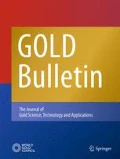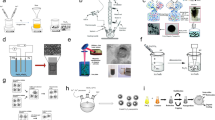Abstract
This work introduces an innovative new method to transport gold nanoparticles (Au-NPs) toward specific organs using as transporter the M13 filamentous phage. The aim is to improve the radiotherapy efficiency by injecting gold nanoparticles in the tumor tissues in order to increase the effective atomic number and, consequently, to produce higher locally deposited doses. The biocompatible Au-NPs can be bonded to the phage surface for their transport in the biological fluids and tissues. M13 phages can be prepared to arrive in specific tissues and organs depending on their biochemical preparation and functionalization. Evidence about the real attachment of spherical Au-NPs, 10 nm in diameter, to the M13 phages is obtained using different microscopies. Other analyses have been also performed to evaluate the number of gold nanoparticles that can be transported by M13 phages inside the organism. Our results on the study of the spherical Au-NP size distribution, deduced by AFM, EFM, and TEM analyses, have indicated that in average, 2 couples of Au-NPs are attached to each phage. Moreover, the size of the NPs ranges between 10 and 30 nm, demonstrating a little aggregation of the nanoparticles, which remain usefully sized to be vehicled with the blood flux towards specific organs.








Similar content being viewed by others
References
Panzarini E, Mariano S, Carata E, Mura F, Rossi M, Dini L (2018) intracellular transport of silver and gold nanoparticles and biological responses: an update. Int J Mol Sci 19(5):1305
Torrisi L, Silipigni L, Restuccia N, Cuzzocrea S, Cutroneo M, Barreca F, Fazio B, Di Marco G, Guglielmino S (2018) Laser-generated bismuth nanoparticles for applications in imaging and radiotherapy. J Phys Chem Solids 119:62–70
Cheng Y, Samia AC, Meyers JD, Panagopoulos I, Fei B, Burda C (2008) Highly efficient drug delivery with gold nanoparticle vectors for in vivo photodynamic therapy of cancer. J Am Chem Soc 130(32):10643–10647
Raliya R, Saha D, Chadha TS, Raman B, Biswas P (2017) Non-invasive aerosol delivery and transport of gold nanoparticles to the brain. Sci Rep 7:44718
Torrisi L, Restuccia N, Cuzzocrea S, Paterniti I, Ielo I, Pergolizzi S, Cutroneo M, Kovacik L (2017) Laser-produced Au nanoparticles as X-ray contrast agents for diagnostic imaging. Gold Bull 50(1):51–60
Mirghassemzadeh N, Ghamkhari M, Dorranian D (2013) Dependence of laser ablation produced gold nanoparticles characteristics on the fluence of laser pulse. Soft Nanoscience Letters 3(4):101–106
Hashmi AS, Hutchings GJ (2006) Gold catalysis. Angew Chem Int Ed 45:7896–7936
Butler JL, Angelini T, Tang JX, Wong GCL (2003) Ion multivalence and like-charge polyelectrolyte attraction. Phys Rev Lett 91:028301
LiY CK, Li S, Nguyen HG, Niu Z, You S, Mello CM, Lu X, Wang Q (2010) Chemical modification of M13 bacteriophage and its application in cancer cell imaging. Bioconjug Chem 21:1369–1377
Byeon HH, Lee SW, Lee EH, Kim W, Yi H (2016) Biologically templated assembly of hybrid semiconducting nanomesh for high performance field effect transistors and sensors. Sci Rep 6:35591
Brigati JR, Petrenko VA (2005) Thermostability of landscape phage probes. Anal Bioanal Chem 382:1346–1350
Lentini G, Fazio E, Calabrese F, De Plano LM, Puliafico M, Franco D, Nicolò MS, Carnazza S, Trusso S, Allegra A, Neri F, Musolino C, Guglielmino SPP (2015) Phage–AgNPs complex as SERS probe for U937 cell identification. Biosens Bioelectron 74:398–405
De Plano LM, Scibilia S, Rizzo MG, Crea S, Franco D, Mezzasalma AM, Guglielmino SPP (2018) One-step production of phage–silicon nanoparticles by PLAL as fluorescent nanoprobes for cell identification. Applied Physics A 124:222
Garcia MA (2011) Surface plasmons in metallic nanoparticles: fundamentals and application J Phys D Appl Phys, IOP Publshing, 2011, 44 (28), pp.283001
Ibrahimkutty S, Wagener P, Menzel A, Plech A, Barcikowski S (2012) Nanoparticle formation in a cavitation bubble after pulsed laser ablation in liquid studied with high time resolution small angle x-ray scattering. Appl Phys Lett 101:103104
Volkert AA, Subramaniam V, Ivanov MR, Goodman AM, Haes AJ (2011) Salt-mediated self assembly of thioctic acid on gold nanoparticles. ACS Nano 5(6):4570–4580
Gwyddion image processing software, Actual website 2018: http://gwyddion.net/
Antibody design laboratories, quantification of bateriophage by spectrophotometry, actual website 2018: http://www.abdesignlabs.com/technical-resources/bacteriophage-spectrophotometry/
Nghiem THL, La TH, Vu XH, Chu VH, Nguyen TH, Le QH, Fort E, Do QH, Tran HN (2010) Synthesis, capping and binding of colloidal gold nanoparticles to proteins. Adv Nat Sci Nanosci Nanotechnol 1:025009
Kelly LA, Thomas GJ Jr (1991) Raman spectroscopy of filamentous bacteriophage Ff (fd, M13, f1) incorporating specifically- Deuterated alanine and tryptophan side chains. Biophys J 60:1337–1349
Wolkers WF, Haris PI, Pistorius AMA, Chapman D, Hemminga MA (1995) The in situ aggregational and conformational state of the major coat protein of bacteriophage M13 in phospholipid bilayers mimicking the inner membrane of host Escherichia coli. Biochemistry 34:7825–7833
Blaik RA, Lan E, Huang Y, Dunn B (2016) Gold-Coated M13 Bacteriophage as a template for glucose oxidase biofuel cells with direct electron transfer. ACS Nano 10:324–332
Wang LS (2010) Covalent gold. Phys Chem Chem Phys 12:8694–8705
Torrisi L, Restuccia N, Paterniti I (2018) Gold nanoparticles by laser ablation for X-ray imaging and protontherapy improvements. Recent Patents on Nanotechnology 12:59–69
Funding
This work was financially supported by the Research & Mobility project of Messina University No. 74893496. This work was financially supported also by the project ASCRS, GACR “Center of Excellence,” N. P108/12/G108.
Author information
Authors and Affiliations
Corresponding author
Additional information
Publisher’s Note
Springer Nature remains neutral with regard to jurisdictional claims in published maps and institutional affiliations.
Rights and permissions
About this article
Cite this article
Torrisi, L., Guglielmino, S., Silipigni, L. et al. Study of gold nanoparticle transport by M13 phages towards disease tissues as targeting procedure for radiotherapy applications. Gold Bull 52, 135–144 (2019). https://doi.org/10.1007/s13404-019-00266-w
Received:
Accepted:
Published:
Issue Date:
DOI: https://doi.org/10.1007/s13404-019-00266-w




